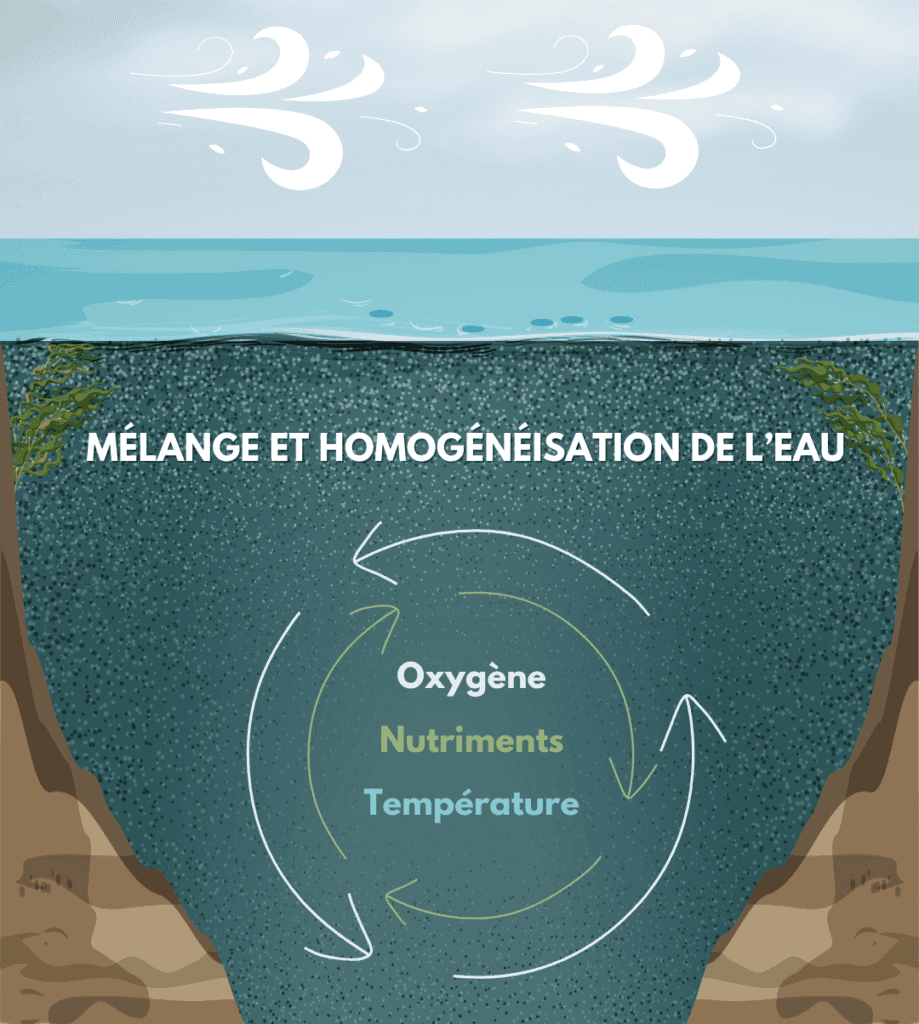13 consecutive winters of incomplete brewing, an all-time record
Mixing ensures optimal reoxygenation of deep waters. Since 2012, however, this phenomenon has been partial. This winter, water masses only mixed at a depth of 110 meters, or just over a third of the lake's 309-meter depth. This historical record of thirteen consecutive winters without complete mixing is causing lasting disruption to the ecosystem. If this trend continues, Lake Geneva risks evolving towards a state of reduced vertical exchange, accentuating the contrast between the deoxygenated, nutrient-rich deep layers and the oxygenated, nutrient-reduced surface waters.
Why does Lake Geneva no longer stir completely?
Vertical winter mixing is based on two key factors:
- Surface water cooling: as air temperature drops, surface water cools, becomes denser and can sink to deeper waters.
- Wind action: sufficiently strong winds should generate vertical currents to homogenize the water column.
Global warming is disrupting these dynamics:
- Increasingly mild winters are preventing surface waters from cooling sufficiently. This winter, the minimum temperature recorded in the surface layer reached 7.8°C, 1.5°C higher than the 1991-2020 average.
- Increased thermal stratification: The temperature difference between the warmer, lighter surface waters and the colder, heavier deep waters is increasing, making mixing more difficult. A key indicator, Schmidt stability, which measures the lake's resistance to mixing, shows a marked increase since 2012.
Renewal of deep waters more complex than expected
In 2024, a study by the École Polytechnique Fédérale de Lausanne (EPFL), based on CIPEL data, revealed that the complete mixing of 2012 was not only due to vertical mixing, but also to lateral flows from the Petit Lac (maximum depth: 70 m) and the coastal areas of the Grand Lac. These currents, generated by faster cooling of the shallow waters, contributed to oxygenation of the deeper layers. With global warming, complete vertical mixing will become rarer, but these lateral currents will continue to play an important role.
Ecological consequences: ecosystem functioning in transition
- Deoxygenation of deep waters
In 2025, dissolved oxygen concentration at depths of 300-309 m is 2.4 mg/L, well below the critical threshold of 4 mg/L required for the survival of sensitive species. This level represents a 70% drop compared to 2012 (8.4 mg/L).
These hypoxic deep-water conditions impact the survival of deep-sea fauna, particularly oligochaete worms and molluscs.
What's more, the absence of complete mixing over the past 13 years has led to stagnation of deep waters, causing a 1.2°C rise in their temperature and modifying the lake's physico-chemical processes. - Disruption of the food chain
The functioning of the ecosystem is based on seasonal synchronization between phytoplankton, zooplankton and fish, regulated by the nutrients, temperature and sunlight required for photosynthesis. Winter mixing plays a key role, providing nutrients at the crucial moment when phytoplankton begin their spring growth through photosynthesis, producing the oxygen essential to the entire ecosystem.
This process is fundamental, as phytoplankton forms the basis of the food chain: it feeds zooplankton and regulates its biomass, thus ensuring the balance of fish populations. In Lake Geneva, however, we are currently witnessing a decline in zooplankton and a weakening of the fish community, compromising the lake's ecological balance. - Nutrient accumulation at depth and risk to uses of Lake Geneva
Without complete mixing, nutrients accumulate in deep waters instead of being redistributed at the surface. If complete mixing were to occur suddenly following an exceptionally cold and windy winter, their sudden release could trigger a massive algal bloom. This would temporarily impair water quality, disrupt biodiversity and impact on the uses of Lake Geneva, notably swimming and drinking water production.
Lake Geneva in a phase of unprecedented transition
Lake Geneva already experienced a long period without complete mixing between 1986 and 1999. However, the effects of global warming are reducing the chances of a spontaneous return to normal.
Lake Geneva is now going through an unprecedented transitional phase, influenced not only by climate change, but also by the proliferation of the quagga mussel, an invasive species capable of profoundly transforming the lake's ecosystem.
Research stepped up to preserve Lake Geneva
Faced with these changes, CIPEL is stepping up its efforts to better understand the ecological dynamics of Lake Geneva and its evolution. A number of priorities are being developed for 2025:
- The study on understanding zooplankton collapse and its impact on ecosystem functioning.
- The SEDLEM'25 project, which analyzes the evolution of environmental conditions in deep waters and sediments, and their effects on the organisms living there.
- Closer monitoring of the expansion of the quagga mussel, while trying to limit its dispersal and prevent the arrival of other invasive species.
- Analysis of emerging pollutants, such as micropollutants and microplastics, to identify their sources and quantify their contribution.
A collective challenge to preserve an exceptional natural heritage
The evolution of Lake Geneva is a direct reflection of global warming. Around the world, large lakes are among the leading indicators of global change. Rigorous monitoring and appropriate measures are essential to understand these transformations and anticipate their impact.
These initiatives are essential to preserve water quality and ensure the resilience of Lake Geneva in a sustainable management perspective. Preserving Lake Geneva, this exceptional natural heritage and the largest freshwater island in Western Europe, is a collective challenge. It involves the commitment of scientists, public authorities, political decision-makers and citizens alike.









